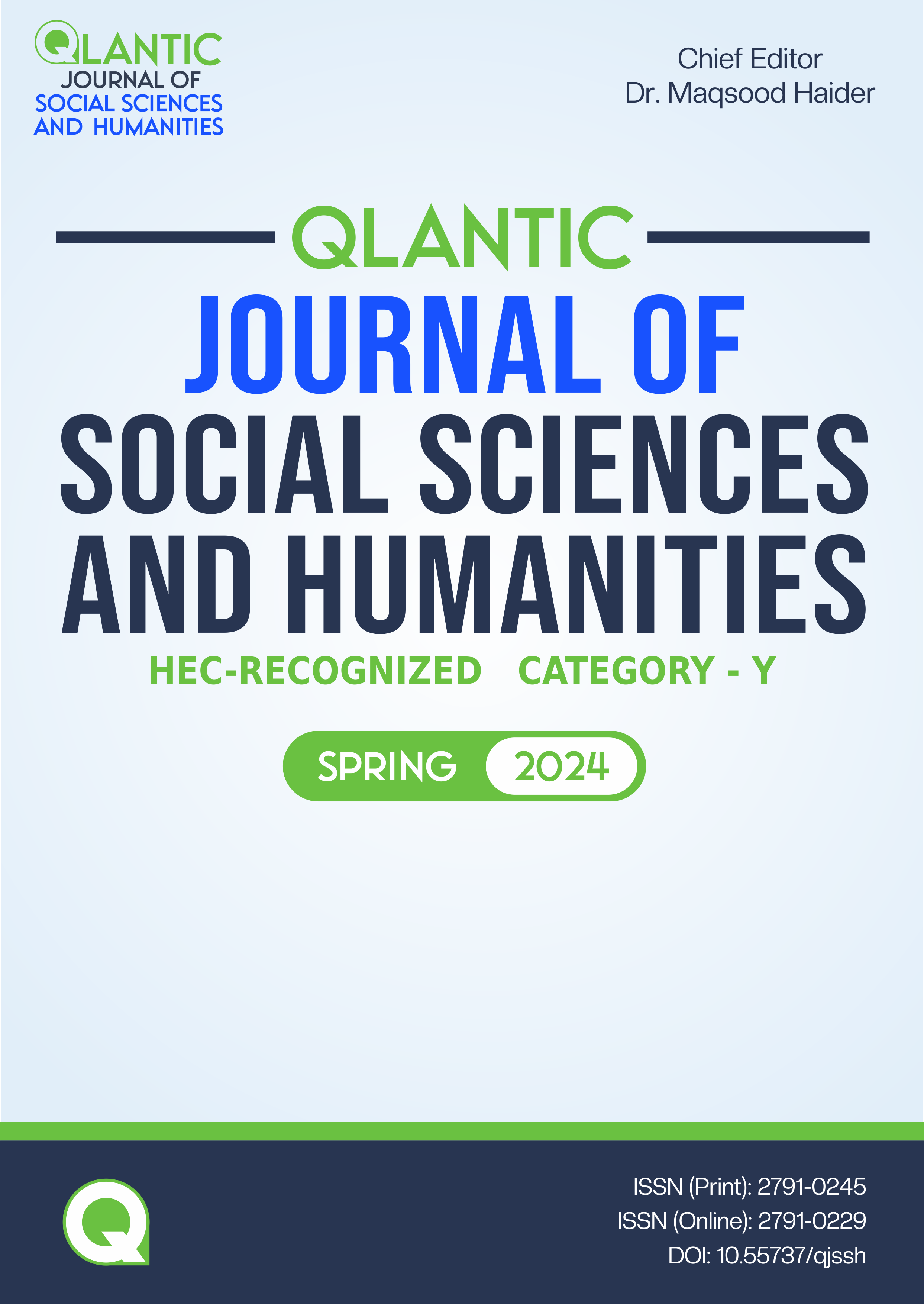Extant Literature Review on Understanding of Domestic Violence against Women in Rural Sindh, Pakistan
DOI:
https://doi.org/10.55737/qjssh.371515457Keywords:
Domestic Violence, Patriarchy, Masculinity, Review, Sindh, PakistanAbstract
This paper presents detailed critiques of existing literature and debate on crucial issues of domestic violence against women in Rural Sindh, Pakistan. Primarily, definitions, causes, consequences, and prevention of domestic violence, as well as sociological and feminist theoretical framework perspectives, are discussed profoundly. Discussions and analyses of past materials, meanings, nature, and scope of studies on domestic violence worldwide and in Sindh, Pakistan, backgrounds are discussed. Patriarchy, masculinity, and their relation to domestic violence are briefly elaborated. The international perspective on domestic violence, ideology and concept of patriarchy, men and masculinity connecting to the situations of marriage, gender relations, roles, legal and religious perspective in Pakistan about domestic violence in Sindh, and previously reported incidence is also reviewed. Likewise, relevant literature and its review on the topic of past studies, connecting with the present study, have also been established with relevant theories, which have overlapping effects on domestic violence. Literature review sections of papers define that there is not any single theory or reason; rather, there are multiple socio-economic, psychological, and feminist viewpoints which allow perpetrators to commit domestic violence against women in rural Sindh, Pakistan.
References
Abdullah, F., Shahzad, M., Abbasi, I., Riaz, F., & Fatima, S. (2015). Comparative study of physical violence on women in a rural area and urban area of Muzaffarabad, AJK. The Explorer Islamabad: Journal of Social Sciences, 1(5), 153-157.
Ahmad, N., & Baig, T. (2015). Construction of Masculinities through Stereotypical Masculine Attributes in THINGS FALL APART. Pakistan Journal of Social Sciences (PJSS), 35(2), 557-571. https://pjss.bzu.edu.pk/index.php/pjss/article/view/334/299
Ali, T. S., Asad, N., Mogren, I., & Krantz, G. (2011). Intimate partner violence in urban Pakistan: prevalence, frequency, and risk factors. International Journal of Women’s Health, 3, 105. https://doi.org/10.2147/ijwh.s17016
Allen, C., & Straus, M. A. (1979). Resources, power, and husband-wife violence. In M. A. Straus & G. Hotaling (Eds.), Social causes of husband-wife violence Minneapolis, MN: University of Minnesota Press.
Amaral, R. (21 March 2011). Explaining domestic violence using feminist theory. www.psychologyforgrowth.com/domestic-violence-feminist-theory
Anderson, K. L., & Umberson, D. (2001). Gendering Violence: Masculinity and Power in Men’s Accounts of Domestic Violence. Gender & Society, 15(3), 358–380. https://doi.org/10.1177/089124301015003003
Aurat Foundation (2013). Beyond denial: violence against women in Pakistan: A qualitative review of reported incidents. http://wwwaforgpk/PDF/VAW%20Reports%20AND%20PR/Annual%20Report%202012%20VAW%20pdfpdf
Bhagwandas. (2014). Sindh records 421 cases of violence against women in three months. www.dawn.com/news /1137184
Bhasin, K. (2004). EXPLORING MASCULINITY l. Waging Peace, Building a World in which Life Matters: Festschrift to Honour Gabriele Dietrich, 292.
Bhatti, A. G., Khoso, A. A., & Buriro, A. A. (2012). Attitudes of working and non-working women about domestic violence: an analytic study of Hyderabad. The Women-Annual Research Journal of Gender Studies. 4, 80-96. https://www.usindh.edu.pk/igs/Research%20Journal/November%202013/07%20ANISA%20GUL%20-AYAZ%20KHOSO-AMEER%20BURIRO%20&%20DUR-E-SHEWAAR.pdf
Bogal-Allbritten, R., & Daughaday, L. R. (1990). Spouse abuse program services: a rural urban comparison. Human Services Rural Environment, 14(2), 6–10.
Buriro, A. A., (2020). Men’s understanding about Domestic Violence in Rural Sindh, Pakistan. (Thesis dissertation submitted at USM, Malaysia).
Chandio, R. (2008). Sindh became hub of crimes under previous govt. http://nation.com.pk/karachi/28-Nov-2008/Sindh-became-hub-of-crimes-under-previous-govt
Chaudhuri, S., Morash, M., & Yingling, J. (2014). Marriage Migration, Patriarchal Bargains, and Wife Abuse; A Study of South Asian Women. Violence against Women, 20(2), 141–161. https://doi.org/10.1177/1077801214521326
Critelli, F. M. (2010). Women’s rights=human rights: Pakistani women against gender violence. Journal of Sociology and Social Welfare, 37(2), 135–160. https://heinonline.org/HOL/LandingPage?handle=hein.journals/jrlsasw37&div=20&id=&page=
Cromwell, R. E., & Olsen, D. H. (1975). Power in families. Sage.
Dobash, R. E., & Dobash, R. (1979). Violence against wives: A case against the patriarchy (Pp. 41-206). New York: Free Press.
Gelles, R. J. (1980). Violence in the Family: A Review of Research in the Seventies. Journal of Marriage and the Family, 42(4), 873–885. https://doi.org/10.2307/351830
Gelles, Richard J. "An exchange/social control theory." The dark side of families: Current family violence research (1983): 151-165.
Gelles, R. J. (2007). The Politics of Research: The Use, Abuse, and misuse of Social Science Data?The Cases of Intimate Partner Violence. Family Court Review, 45(1), 42–51. https://doi.org/10.1111/j.1744-1617.2007.00127.x
Gelles, R. J., & Straus, M. A. (1979). Determinants of violence in the family: Toward a theoretical interpretation. Contemporary Theories About the Family, Free, New York.
Goode, W. J. (1971). Force and Violence in the Family. Journal of Marriage and the Family, 33(4), 624. https://doi.org/10.2307/349435
Hunnicutt, G. (2009). Varieties of patriarchy and violence against women: Resurrecting “patriarchy” as a theoretical tool. Violence against Women, 15(5), 553–573. https://doi.org/10.1177/1077801208331246
Itulua-Abumere, F. (2013). Understanding Men and Masculinity in Modern Society. Open Journal of Social Science Research, 1(2), 42–45. https://doi.org/10.12966/ojssr.05.05.2013
Koenig, M. A., Ahmed, S., Hossain, M. B., & Mozumder, A. B. M. K. A. (2003). Women’s Status and Domestic Violence in Rural Bangladesh: Individual- and Community-Level Effects. Demography, 40(2), 269–288. https://doi.org/10.1353/dem.2003.0014
Kuhlmann, E., & Babitsch, B. (2002). Bodies, health, gender—bridging feminist theories and women’s health. Women’s Studies International Forum, 25(4), 433–442. https://doi.org/10.1016/s0277-5395(02)00280-7
Loue, S. (2001). Intimate partner violence: Societal, medical, legal and individual responses. Springer Science & Business Media.
Pence, E., & Paymar, M. (1993). Education groups for men who batter: The Duluth model. Springer Publishing Company.
Rashid. S., Malik. F. M., Maryam. M., & Zeeshan. Z. (2012). The Reasons behind Domestic violence in rural families of Pakistan: The Masculine perspective. http://www.academia.edu/6047326/Domestic_violence_in_rural_families_of_Pakistan
Schuler, S. R., Hashemi, S. M., Riley, A. P., & Akhter, S. (1996). Credit programs, patriarchy and men’s violence against women in rural Bangladesh. Social Science & Medicine, 43(12), 1729–1742. https://doi.org/10.1016/s0277-9536(96)00068-8
Seymour, K. (2009). `Real’ violence?: Gender and (male) violence — an Australian perspective. Probation Journal, 56(1), 29–44. https://doi.org/10.1177/0264550508099714
Sultana, A. (2012). Patriarchy and Women’s subordination: A theoretical analysis. Arts Faculty Journal, 1-18. https://doi.org/10.3329/afj.v4i0.12929
United Nations. (1993). General Assembly Declaration on the Elimination of Violence against Women (20 December 1993). http://www.un.org/documents/ga/res/48/a48r104.html
Walby, S. (1989). Theorizing patriarchy. Sociology, 23(2), 213-234. https://doi.org/10.1177/0038038589023002004
Walby, S. (1986). Patriarchy at work: patriarchal and capitalist relations in employment . (Feminist perspectives from Polity Press). Polity Press.
Walby, S., & Allen, J. (2004). Domestic violence, sexual assault and stalking: Findings from the British Crime Survey. Home Office.
Wilson, A. (2000). Patriarchy: feminist theory. Routledge International Encyclopaedia of Women: Global Women’s Issues and Knowledge. New York: Routledge.
World Bank. (2011). World Bank annual report, 2011. Washington: World Bank.
World Health Organization. (2016). Preventing intimate partner and sexual violence against women: taking action and generating evidence. Injury Prevention, 16(5), 359–360. https://doi.org/10.1136/ip.2010.029629
Yount, K. M. (2005). Resources, Family Organization, and Domestic Violence Against Married Women in Minya, Egypt. Journal of Marriage and Family, 67(3), 579–596. https://doi.org/10.1111/j.1741-3737.2005.00155.x
Zakar, R. (2012). Intimate partner violence against women and its implications for women's health in Pakistan. Disserta Verlag.
Zakar, R., Zakar, M. Z., & Abbas, S. (2015). Domestic Violence Against Rural Women in Pakistan: An Issue of Health and Human Rights. Journal of Family Violence, 31(1), 15–25. https://doi.org/10.1007/s10896-015-9742-6
Zakar, R., Zakar, M. Z., & Kraemer, A. (2013). Men’s Beliefs and Attitudes Toward Intimate Partner Violence Against Women in Pakistan. Violence against Women, 19(2), 246–268. https://doi.org/10.1177/1077801213478028
Zakar, R., Zakar, M. Z., & Krämer, A. (2012). Voices of strength and struggle: women’s coping strategies against spousal violence in Pakistan. Journal of Interpersonal Violence, 27(16), 3268–3298. https://doi.org/10.1177/0886260512441257
Published
Issue
Section
License
Copyright (c) 2024 Ameer Ali Buriro, Muhammad Ali, Syed Abbas Ali Shah

This work is licensed under a Creative Commons Attribution-NonCommercial 4.0 International License.





